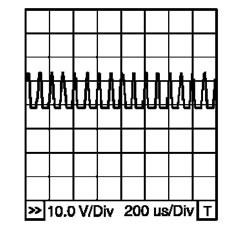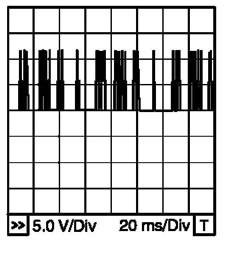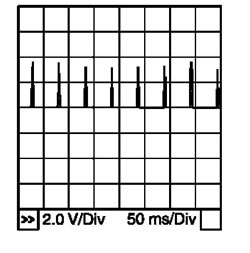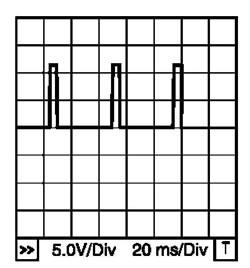ECM connector pins (from the wiring side)

Below are the test conditions and the corresponding signals taken from the pins of the ECM connector.
| Contact | Device | Conditions | Signal |
| 1 | ECM ground | The engine is running at speed X / X | Motor ground |
| 2 | Post catalytic lambda probe heater | A warm engine runs at a speed of no more than 3800 rpm | 0÷1 V |
| Engine off (ignition on) or the engine is running above 3800 rpm | 11÷14 V | ||
| 3 | Throttle Actuator Relay Power | Ignition on | 11÷14 V |
| 4 (5) | Throttle actuator in closed (open) position | Engine off, ignition on, gas pedal released, manual transmission in 1st gear (AT in mode "D") |
Throttle actuator signal in closed position (voltage 0÷14 V)
Throttle actuator open signal (voltage |
| 13 | CKP sensor | The engine is warm and running at X / X speeds |
CKP sensor signal on X/X (average voltage 3 V) |
| Engine running at 2000 rpm |
CKP sensor signal at 2000 rpm (average voltage 3 V) | ||
| 14 | CKP sensor | The engine is warm and running at X / X speeds |
CMP sensor signal on X/X (voltage 1÷4 V) |
| Engine running at 2000 rpm |
CMP sensor signal at 2000 rpm (voltage 1÷4 V) | ||
| 15 | Knock sensor | The engine is running at speed X / X | About 2.5 V |
| 16 | Post catalytic lambda probe | The engine is warm and running at a speed not exceeding 3600 rpm | 0÷1 V |
| 19 | Solenoid absorber purge control valve | The engine is running at speed X / X |
Signal e / m control valve purge absorber X / X (voltage 11÷14 V) |
| Engine running at 2000 rpm |
2000 rpm absorber purge control valve signal (average voltage 10 V) | ||
| 22, 23, 41, 42 | Injector No. 3,1,4,2 respectively | The engine is warm and running at X / X speeds |
Injector signal on X/X (voltage 11÷14 V) |
| The engine is warm and running at 2000 rpm |
Injector signal at 2000 rpm (voltage 11÷14 V) | ||
| 24 | Pre-catalytic lambda probe heater | The engine is warm and running at a speed not exceeding 3600 rpm |
Signal of the heater of the pre-catalytic lambda probe at speeds not higher than 3600 rpm (average voltage 7 V) |
| The engine is warm and running at speeds above 3600 rpm | 11÷14 V | ||
| 29 // 30 | Sensor ground CMP // CKP | The engine is running at speed X / X | About 0 V |
| 34 | IAT sensor | engine running | 0÷4.8 V, depending on temperature |
| 35 | Pre-catalytic lambda probe | The engine is warm and running at 2000 rpm | 0÷1 V (periodic change) |
| 45 | Sensor power supply | Ignition on | About 5V |
| 46 // 47 | Refrigerant Pressure Sensor Supply A/C // TPS Sensor | Ignition on | About 5V |
| 49 | TPS 1 sensor | Engine off, ignition on, accelerator pedal released/depressed, manual transmission in 1st gear (AT in mode "D") | More than 0.36V // Less than 4.75V |
| 51 | MAP sensor | The engine is warm and running at X / X speeds | About 1.5 V |
| The engine is warm and running at 2000 rpm | About 1.2V | ||
| 54 // 56 // 57 | Knock sensor ground // MAP // A/C refrigerant pressure sensor | The engine is warm and running at X / X speeds | About 0 V |
| 60, 61, 79, 80 | Ignition signal in cylinder No. 3,1,4,2 respectively | The engine is warm and running at X / X speeds |
Ignition signal on X/X (voltage |
| The engine is warm and running at 2000 rpm |
Ignition signal at 2000 rpm (voltage | ||
| 62 | E/m the valve of management of phases of inlet valves | The engine is warm and running at X / X speeds |
Signal e/m of the valve of management of phases of inlet valves on Х/Х (voltage |
| With an increase in the speed of a warm engine up to 2000 rpm |
Signal from the e / m valve for controlling the phases of the intake valves at 2000 rpm (voltage | ||
| 66 | Grounding TPS sensors | The engine is warm and running at X / X speeds | About 0 V |
| 68 | TPS 2 sensor | Engine off, ignition on, accelerator pedal released/depressed, manual transmission in 1st gear (AT in mode "D") | Less than 4.75V // More than 0.36V |
| 69 | Refrigerant pressure sensor | The engine is warm and running; A/C and heater fan included | 1÷4 V |
| 72 | ECT sensor | engine running | 0÷4.8 V, depending on temperature |
| 73 / 74 / 82 / 83 | Grounding the ECT sensor / lambda probe / APP1 / APP2 sensor | The engine is warm and running at X / X speeds | About 0 V |
| 85 | Diagnostic connector | Ignition on, scanner disconnected | 11÷14 V |
| 86 | CAN bus | Ignition on | 1.0÷2.5 V |
| 90 / 91 | APP1/APP2 sensor power supply | Ignition on | About 5V |
| 92 | TPS sensor output (models with AT) | Engine off, ignition on, AT in mode "D", gas pedal released // depressed | About 0.5V // 4.2V |
| 94 | CAN bus | Ignition on | 2.5÷4.0 V |
| 98 | APP sensor 2 | Engine off, ignition on, accelerator pedal released/depressed | 0.3÷0.6V // 1.95÷2.4V |
| 101 | D/B brake lights | Brake pedal released/depressed | 0 V // 11÷14 V |
| 102 | PNP sensor | Ignition on, AT in position "P" or "N" (Gearbox in neutral) | About 0 V |
| Ignition on, transmission in other positions | 11 ÷14 V | ||
| 103 | Tachometer output (models with AT) | The engine is warm and running at X / X speeds |
Tachometer output (models with AT) on X/X (voltage 10÷11 V) |
| Engine running at 2000 rpm |
Tachometer output (models with AT) at 2000 rpm (voltage 10÷11 V) | ||
| 104 | Throttle relay | Ignition off // on | 11÷14V // 0÷1V |
| 106 | APP sensor 1 | Engine off, ignition on, accelerator pedal released/depressed | 0.6÷0.9 V // 3.9÷4.7 V |
| 109 | ignition switch | Ignition off // on | 0 V // 11÷14 V |
| 111 | ECM relay | Within // 5 s after turning off the engine (ignition off) | 0÷1V // 11÷14V |
| 113 | Fuel pump relay | Within // 1 s after the ignition is switched on | 0÷1V // 11÷14V |
| 115, 116 | ECM ground | The engine is running at speed X / X | Motor ground |
| 119, 120 | ECM Power | Ignition on | 11÷14 V |
| 121 | ECM backup power | Ignition off | 11÷14 V |
Note. The waveforms displayed on the Nissan scan tool are shown above. Under each oscillogram, the scale division value is indicated.
DMMs are great for testing static electrical circuits and for capturing slow changes in monitored parameters. When conducting dynamic checks performed on a running engine, as well as in identifying the causes of periodic failures, an oscilloscope becomes an absolutely indispensable tool.
Some oscilloscopes allow you to save waveforms in the built-in memory module with subsequent printing of the results or copying them to digital media already in stationary conditions.
The oscilloscope allows you to observe periodic signals and measure the characteristics of rectangular pulses, as well as the levels of slowly changing voltages. The oscilloscope can be used for:
- Detection of unstable failures;
- Checking the results of the corrections made;
- Monitoring the activity of the lambda probe;
- Analysis of the signals generated by the lambda probe, the deviation of the parameters of which from the norm is an unconditional evidence of a malfunction in the functioning of the control system as a whole - on the other hand, the correctness of the shape of the pulses issued by the lambda probe can serve as a reliable guarantee of the absence of violations in the control system.
The reliability and ease of use of today's oscilloscopes do not require special knowledge and experience from the operator. Interpretation of the information obtained can be easily done by an elementary visual comparison of the oscillograms taken during the test with the following time dependences, typical for various sensors and actuators of automotive control systems.
Parameters of periodic signals
Arbitrary signal characteristics

Each signal taken with an oscilloscope can be described using the following basic parameters:
- amplitude - the difference between the maximum and minimum voltages (IN) signal within the period;
- period – signal cycle duration (ms);
- frequency - number of cycles per second (Hz);
- width is the duration of the rectangular pulse (ms, ms);
- duty cycle is the ratio of the repetition period to the width (In foreign terminology, the inverse duty cycle parameter is used called work cycle, expressed in %);
- waveform – a train of rectangular pulses, spiking, sine wave, sawtooth pulses, etc.
Usually, the characteristics of the failed device are very different from the reference, which allows the operator to easily and quickly visually identify the failed component.
DC signals – only the signal voltage is analyzed.
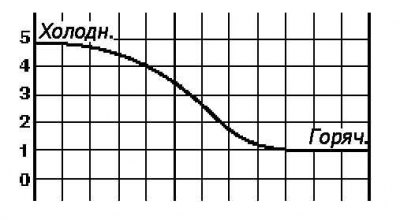
ECT sensor signal
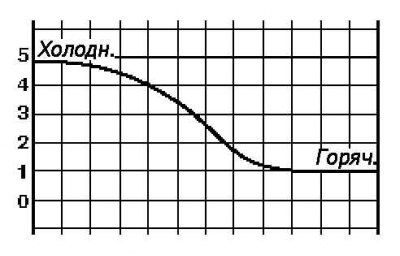
IAT sensor
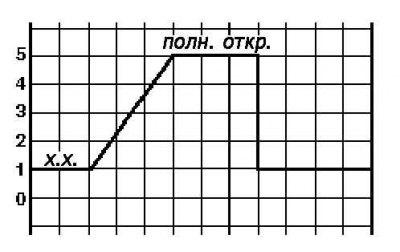
TPS sensor

Lambda probe
AC signals – the amplitude, frequency and shape of the signal are analyzed.
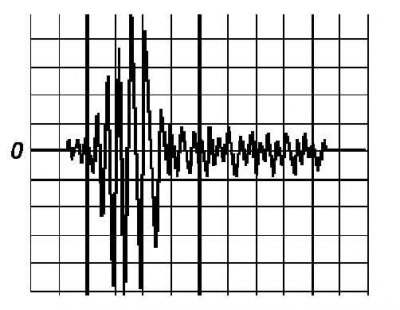
knock sensor
Frequency Modulated Signals – amplitude, frequency, signal shape and width of periodic pulses are analyzed.

Inductive sensor CKP

CMP inductive sensor

Inductive sensor VSS

Hall effect speed and shaft position sensors

Optical speed and shaft position sensors

Digital MAF and MAP sensors
Pulse Width Modulated Signals (PWM) – the amplitude, frequency, signal shape and duty cycle of periodic pulses are analyzed.

fuel injector
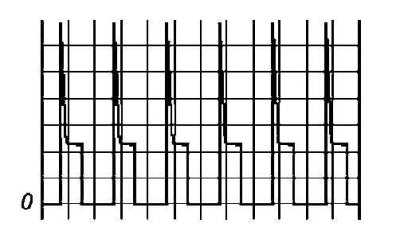
Speed stabilization device Х/Х (IAC)
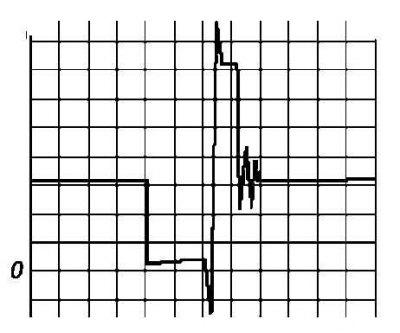
Primary winding of the ignition coil
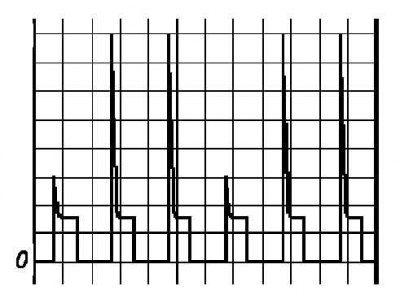
E/m valve of a purge of an adsorber of the EVAP system

EVAP valves
The waveform produced by an oscilloscope depends on many different factors and can vary greatly.
In view of the foregoing, before proceeding with the replacement of the suspected component in the event that the shape of the captured diagnostic signal does not match the reference waveform, the result should be carefully analyzed.

digital signal

analog signal
Voltage
The zero level of the reference signal cannot be considered as an absolute reference value, – "zero" the real signal, depending on the specific parameters of the circuit under test, may be shifted relative to the reference (see range 1 in the illustration Digital signal) within a certain allowable range (see range 2 in the illustration Digital signal and 1 in the illustration Analog signal).
The full amplitude of the signal depends on the supply voltage of the tested circuit and can also vary relative to the reference value within certain limits (see range 2 in the illustration Digital signal and 2 in the illustration Analog signal).
In DC circuits, the signal amplitude is limited by the supply voltage. An example is the idle speed stabilization circuit (IAC), the signal voltage of which does not change in any way with a change in engine speed.
In AC circuits, the signal amplitude already unambiguously depends on the frequency of the signal source. So, the amplitude of the signal generated by the crankshaft position sensor (CKP) will increase with increasing engine speed.
In view of the foregoing, if the amplitude of the signal taken with the oscilloscope is excessively low or high (up to cutting off the upper levels), you just need to switch the operating range of the device by switching to the appropriate measurement scale.
When checking circuits with e / m control (e.g. idle speed control system) voltage surges may occur when the power is turned off (see 4 in the illustration Digital signal), which can be safely ignored when analyzing the measurement results.
Also, don't worry about waveform distortion such as skew at the bottom of the leading edge of the square wave (see illustration 5 for values Digital signal), unless, of course, the very fact of the flattening of the front is not a sign of a malfunction in the functioning of the tested component.
Frequency
The frequency of repetition of signal pulses depends on the operating frequency of the signal source.
The shape of the recorded signal can be edited and brought to a form convenient for analysis by switching the scale of the time base of the image on the oscilloscope.
When observing signals in AC circuits, the time base of the oscilloscope depends on the frequency of the signal source (see range 3 in the illustration Analog signal), determined by engine speed.
As mentioned above, to bring the signal to a readable form, it is enough to switch the time base scale of the oscilloscope.
In some cases, characteristic changes in the signal turn out to be reversed with respect to the reference dependences, which is explained by the reversibility of the connection polarity of the corresponding element and, in the absence of a prohibition on changing the connection polarity, can be ignored in the analysis.
Typical Signals of Engine Control Components
Modern oscilloscopes are usually equipped with two signal wires, coupled with a variety of probes that allow you to connect the device to almost any device.
The red wire is connected to the positive pole of the oscilloscope and is usually connected to the ECM terminal. The black wire must be connected to a properly grounded point (mass).
Injectors
The control of the composition of the air-fuel mixture in modern automotive electronic fuel injection systems is carried out by timely adjustment of the duration of opening of the electromagnetic valves of the injectors.
The duration of stay of the injectors in the open state is determined by the duration of the electrical impulses generated by the ECM, applied to the input of the e / m valves. The duration of the pulses is usually within the range 1÷14 ms.
A typical oscillogram of the pulse that controls the operation of the injector is shown in the illustration Fuel injector. Often, a series of short pulsations can also be observed on the oscillogram, following immediately after the initiating negative rectangular pulse and maintaining the injector solenoid valve in the open state, as well as a sharp positive voltage surge that accompanies the moment the valve closes.
The correct functioning of the ECM can be easily checked with an oscilloscope by visually observing the change in the shape of the control signal with varying engine operating parameters. So, the duration of the pulses when turning the engine at idle should be slightly higher than when the unit is running at low speeds. An increase in engine speed should be accompanied by a corresponding increase in the time the injectors stay open. This dependence is especially well manifested when opening the throttle with short presses on the gas pedal.
Using a thin feeler gauge, connect the red oscilloscope lead to the ECM injector terminal. Second signal wire probe (black) ground the oscilloscope securely.
Analyze the shape of the signal read while cranking the engine.
After starting the engine, check the shape of the control signal at idle.
By sharply pressing the gas pedal, raise the engine speed to 3000 rpm, - the duration of the control pulses at the moment of acceleration should increase markedly, followed by stabilization at a level equal to, or slightly less than, the characteristic idle speed.
Rapid closing of the throttle should lead to a straightening of the oscillogram, confirming the fact of overlapping of the injectors (for systems with fuel cut-off).
During a cold start, the engine needs some enrichment of the air-fuel mixture, which is provided by an automatic increase in the duration of the opening of the injectors. As the duration of the control pulses on the oscillogram warms up, it should continuously decrease, gradually approaching the value typical for idle speeds.
In injection systems that do not use a cold start injector, during a cold start of the engine, additional control pulses are used, which appear on the oscillogram as variable length pulsations.
The table below shows a typical dependence of the duration of the control pulses for opening the injectors on the operating state of the engine.
| Engine condition | Control pulse duration, ms |
idle | 1÷6 |
2000÷3000 rpm | 1÷6 |
Full throttle | 6÷ 35 |
Inductive sensors

1. Start the engine and compare the waveform taken from the output of the inductive sensor with the reference one shown in the illustration.
2. An increase in engine speed should be accompanied by an increase in the amplitude of the pulse signal generated by the sensor.
Lambda probe (oxygen sensor)
Note. This subsection contains oscillograms typical for the most commonly used zirconium-type lambda probes in cars, which do not use a reference voltage of 0.5 V. Recently, titanium sensors have become increasingly popular, the operating signal range of which is 0 ÷ 5 V, and the voltage level is issued during the combustion of a lean mixture, low - enriched.
1. Connect an oscilloscope between the lambda probe terminal on the ECM and ground.
2. Make sure the engine is warmed up to normal operating temperature.

3. Compare the oscillogram displayed on the screen of the meter with the reference one shown in the illustration.
4. If the recorded signal is not wavelike, but is a linear relationship, then, depending on the voltage level, this indicates excessive over-depletion (0÷0.15 V), or reenrichment (0.6÷1 V) air-fuel mixture.
5. If there is a normal undulating signal at idle, try to sharply squeeze the gas pedal several times - the signal fluctuations should not go out of range 0÷1 V.
6. An increase in engine speed should be accompanied by an increase in signal amplitude, a decrease - by a decrease.
Ignition signal at the output of the ignition module
1. Connect an oscilloscope between the ignition module terminal on the ECM and ground.
2. Warm up the engine to normal operating temperature and leave it running at idle.

3. A sequence of rectangular DC pulses should be displayed on the oscilloscope screen. Compare the received waveform with the reference waveform, paying close attention to matching parameters such as amplitude, frequency, and pulse shape.
4. With an increase in engine speed, the signal frequency should increase in direct proportion.
Primary winding of the ignition coil
1. Connect an oscilloscope between the ignition coil terminal and ground.
2. Warm up the engine to normal operating temperature and leave it running at idle.

3. Compare the shape of the received signal with the reference - positive voltage surges should have a constant amplitude.
4. Uneven spikes can be caused by excessive secondary winding resistance, as well as a faulty coil I/O wire.

